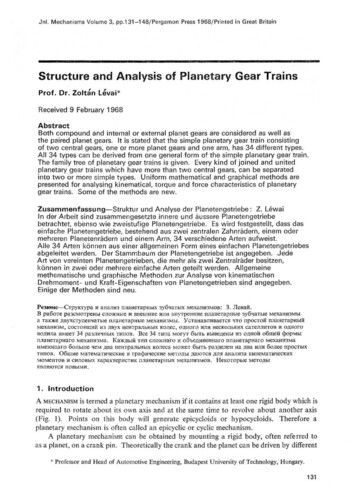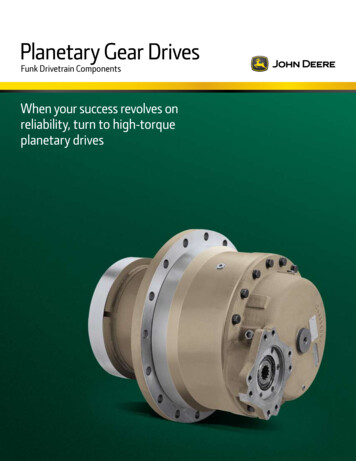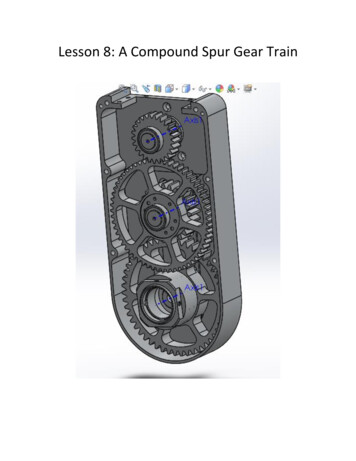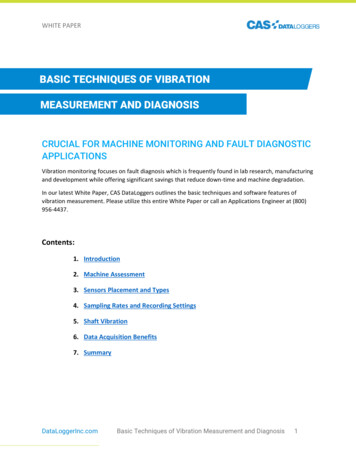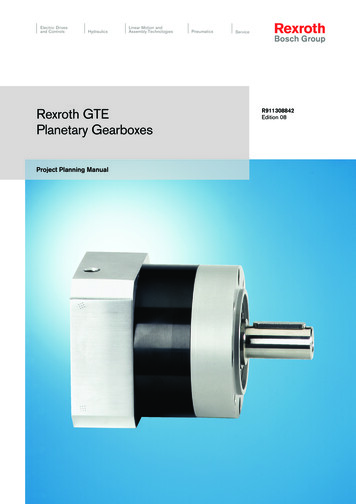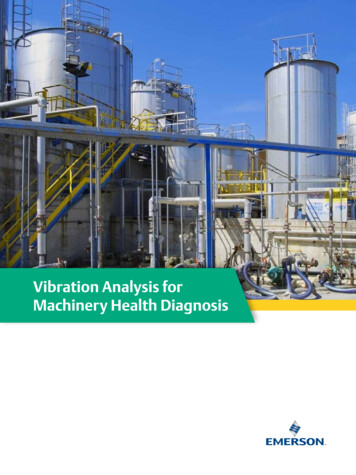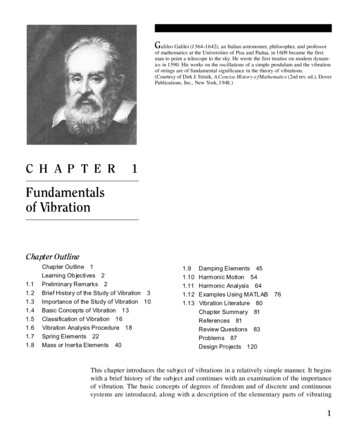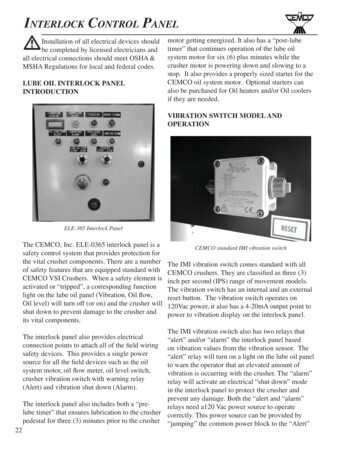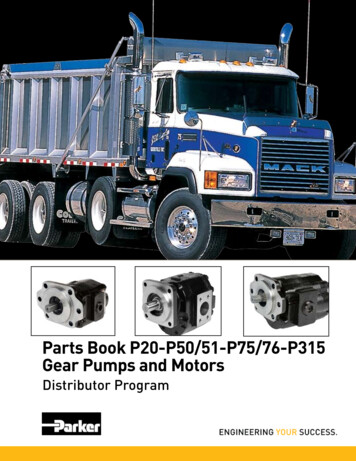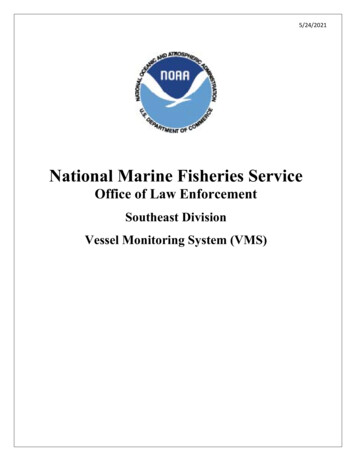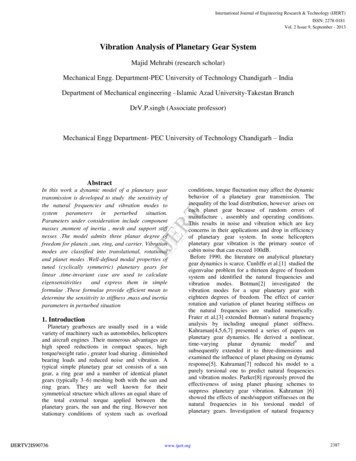
Transcription
International Journal of Engineering Research & Technology (IJERT)ISSN: 2278-0181Vol. 2 Issue 9, September - 2013Vibration Analysis of Planetary Gear SystemMajid Mehrabi (research scholar)Mechanical Engg. Department-PEC University of Technology Chandigarh – IndiaDepartment of Mechanical engineering –Islamic Azad University-Takestan BranchDrV.P.singh (Associate professor)Mechanical Engg Department- PEC University of Technology Chandigarh – IndiaAbstractconditions, torque fluctuation may affect the dynamicbehavior of a planetary gear transmission. Theinequality of the load distribution, however arises oneach planet gear because of random errors ofmanufacture , assembly and operating conditions.This results in noise and vibration which are keyconcerns in their applications and drop in efficiencyof planetary gear system. In some helicoptersplanetary gear vibration is the primary source ofcabin noise that can exceed 100dB.Before 1990, the literature on analytical planetarygear dynamics is scarce. Cunliffe et al.[1] studied theeigenvalue problem for a thirteen degree of freedomsystem and identified the natural frequencies andvibration modes. Botman[2] investigated thevibration modes for a spur planetary gear witheighteen degrees of freedom. The effect of carrierrotation and variation of planet bearing stiffness onthe natural frequencies are studied numerically.Frater et al.[3] extended Botman's natural frequencyanalysis by including unequal planet stiffness.Kahraman[4,5,6,7] presented a series of papers onplanetary gear dynamics. He derived a uently extended it to three-dimensions andexamined the influence of planet phasing on dynamicresponse[5]. Kahraman[7] reduced his model to apurely torsional one to predict natural frequenciesand vibration modes. Parker[8] rigorously proved theeffectiveness of using planet phasing schemes tosuppress planetary gear vibration. Kahraman [6]showed the effects of mesh/support stiffnesses on thenatural frequencies in his torsional model ofplanetary gears. Investigation of natural frequencyIJERTIn this work a dynamic model of a planetary geartransmission is developed to study the sensitivity ofthe natural frequencies and vibration modes tosystem parameters in perturbed situation.Parameters under consideration include componentmasses ,moment of inertia , mesh and support stiffnesses .The model admits three planar degree offreedom for planets ,sun, ring, and carrier. Vibrationmodes are classified into translational, rotationaland planet modes .Well-defined modal properties oftuned (cyclically symmetric) planetary gears forlinear ,time-invariant case are used to calculateeigensensitivitiesand express them in simpleformulae .These formulae provide efficient mean todetermine the sensitivity to stiffness ,mass and inertiaparameters in perturbed situation1. IntroductionPlanetary gearboxes are usually used in a widevariety of machinery such as automobiles, helicoptersand aircraft engines .Their numerous advantages arehigh speed reductions in compact spaces, hightorque/weight ratio , greater load sharing , diminishedbearing loads and reduced noise and vibration. Atypical simple planetary gear set consists of a sungear, a ring gear and a number of identical planetgears (typically 3–6) meshing both with the sun andring gears. They are well known for theirsymmetrical structure which allows an equal share ofthe total external torque applied between theplanetary gears, the sun and the ring. However nonstationary conditions of system such as overloadIJERTV2IS90736www.ijert.org2387
International Journal of Engineering Research & Technology (IJERT)ISSN: 2278-0181Vol. 2 Issue 9, September - 2013and vibration mode sensitivity to system parametersfor tuned and mistuned planetary gears was done byJ.Lin and R.G.Parker [15].They also investigatedthe natural frequency spectra and vibration modes ofplanetary gears to avoid power train resonances.[7 ]2 Modeling and equationsThe analysis deals with planar vibration of singlestage planetary gears .A Lumped-parameter modelused in this work for dynamic analysis is shown inFig 1. All gears are considered as rigid bodies andcomponent supports are modeled by springs. Each ofsun, ring, carrier and Z planets are treated as rigidbodies. Each component has three degrees offreedom: two translational and one rotational. Themodel is similar to that used by Parker [12], theplanet deflections are described by radial andtangential coordinates and more naturally describethe vibration modes. The coordinates illustrated inFig.1 are used. The carrier, ring and suntranslations 𝑎𝑔 , 𝑏𝑔 , where g c,r,s and planettranslations 𝛽𝐿 , 𝛾𝐿 , L 1,.Z are measured withrespect to a rotating frame fixed to the carrier withorigin O. The𝑎𝑔 ′𝑠 are directed towards theequilibrium position of planet 1, and 𝛽𝐿 , 𝛾𝐿 are theradial and tangential deflections of the z-th planet.The rotating frame rotates with the constant carrierangular speed Ωc. The rotational coordinates are𝐽𝑢 𝑟𝑢 𝜃𝑢 ,u c,r,s,1,. Z, where 𝜃𝑢 is the componentrotation; 𝑟𝑢 is the base circle radius for the sun, ringand planet, and the radius of the circle passingthrough the planet centers for the carrier.Circumferential planet locations are specified by thefixed angles 𝑧 , where 𝑧 is measured relative to theIJERTV2IS90736Figure 1. Lumped parameter model of planetarygears and system co-ordinates. (b) All translationalco-ordinates a g , bg , g c, r, s and 𝛽𝐿 , 𝛾𝐿 , L 1,.zare with respect to the frame {i, j, k} rotating atconstant carrier speed Ωc .IJERTAnalytical investigation of the sensitivities of naturalfrequencies and vibration modes to stiffness andinertia parameters of general compound planetarygears for both tuned and mistuned are studied in[12].How the highly structured free-vibration properties ofequally spaced planet systems change due to unequalplanet spacing was studied in[5].Characterizing theeffects of various errors on the dynamic properties ofplanetary gear system including tooth thickness,runout and load sharing as the most common gearsystem manufacturing was done by Parker,R.G. andG.J.Cheon.[13].The effects of some importantparameters ,such as the variation of mesh stiffnessand static transmission errors on the nonlineardynamics of a planetary gear system with multipleclearances was studied in[14].The objective of thispaper is to analytically investigate the naturalfrequency and vibration modes of general planetarygears in perturbed situation and comparing them withunperturbed situation .This allows one to find thedominant parameter effecting the perturbation of thesystem .Investigating the natural frequency spectraone can tune the system to avoid resonance .rotating basis vector i so that 1 0. Fig.1 shows asun planet mesh with masses ms , mp and moment ofinertia𝐼𝑠 , 𝐼𝑝 . ρs is the pressure angle of sun/planetmesh and 𝑠𝑧 𝑧 ρs .Free vibration ,time-invariant representation isconsidered and assumed identical. All planet bearingstiff nesses are equal kpn kp, all sun-planet meshstiffnesses are equal ksn ksp and all ring planet meshstiff nesses are equal krn krp .The planets are equallyspaced and cyclically symmetric structures, thereforecan be divided into Z sector having a central2πangle . Following the matrix derivation of FoxZmethod [16, 17], the general eigenvalue equation forperturbed free vibration is: [19][M][X][𝜆] 𝐾 𝑋 0(1)de perturbation in design variable ‘e’[I] identity matrix[K1 ] unperturbed stiffness matrix[dK e ] perturbation in [K1 ] due to change in designvariable ‘e’.[K] perturbed stiffness matrixλ1 unperturbed eigenvalue matrix (diagonal)[dλe ] perturbation in λ1 due to change in designvariable ‘e’[M1 ] unperturbed mass matrix[dM e ] perturbation in [M1 ] due to change in designvariable ‘e’www.ijert.org2388
International Journal of Engineering Research & Technology (IJERT)ISSN: 2278-0181Vol. 2 Issue 9, September - 2013[M] perturbed mass matrix[X1 ] Unperturbed eigenvector matrix (modeshape)dX e perturbation in [X1 ] due to change in designvariable ‘e’[X] perturbed eigenvector matrix𝑖Where 𝛿𝑠𝑧is the spring deformation of the sun-planetz mesh in mode 𝑋1 given by𝑖𝛿𝑠𝑧 𝑦𝑠 cos 𝑧 ρs 𝑥𝑠 sin 𝑧 ρs 𝛾𝐿 𝑐𝑜𝑠ρs 𝛽𝐿 𝑠𝑖𝑛ρs 𝐽𝑠 𝐽𝑛The rotational mode property implies that all sunM is the inertia matrix and Kb is the bearing stiffnessmatrix given in Appendix A. To model the timevarying stiffness associated with changing numbersof teeth in contact at each mesh, K m can bedecomposedintomeanandtime-varyingcomponents. Tooth separation nonlinearity isimplicitly included in Km(t). Manipulating equation(1) we obtain the first order equation𝑑𝜆𝑒 [𝜌𝑒 ] 𝜆1 𝜆1 𝜌𝑒 [𝜉 𝑒 ](2)The diagonal terms give the eigenvalueperturbations𝑗𝑖planet mesh deformations are equal i.e. 𝛿𝑠𝑧 𝛿𝑠𝑧, soequation (3) becomes 𝜆𝑖 𝑘𝑠𝑝 𝜆 𝑖 𝑚 𝑔 𝜆 𝑖 𝐼𝑔𝜆𝑖𝑟𝑔2IJERTdX (In X1 eTj ). λ1 In M1 1 . (M1 1 X1 X1T)(dK λ1 . dM e )X1TX1 M1 X1Considering the case of equal alteration of all sunplanet mesh stiffness i.e., 𝑘𝑠𝑧 𝑘𝑠𝑝 ,the perturbedsystem remains tuned. The derivatives of the massand stiffness matrices with respect to 𝑘𝑠𝑝 are:[5,12]1 𝜆𝑖 𝑥𝑔2 𝑦𝑔2 eξ λeidλei ii ededeConsidering the case of equal alteration of all sunplanet mesh stiffness i.e., k sz k sp , the perturbedsystem remains tuned. Eigenvector derivative can bewritten as [18]𝑖 2(𝛿𝑠1)The Eigen sensitivity to masses (ms , mr , mc , mp ) andmoment of inertia (Is , Ir , Ic , Ip )for sun ,ring ,carrierand planets for a tuned perturbed system areconsidered ,the eigenvalue derivatives for the threetypes of modes are𝑑𝜆𝑒𝑖 [𝜉𝑖𝑖𝑒 ]Or the derivatives𝑧𝑢𝑔2 𝜆𝑖 𝜆𝑖 𝑚𝑝 𝜆𝑖 𝜆𝑖 2 𝐼𝑔𝑟𝑝2𝑇𝐼𝑔 𝑔𝑗2𝑚𝑔g r ,s ,cZ(𝛽𝐿2L 1 𝑇𝑔𝛾𝐿2 )2 𝑚𝑝Z𝑇𝐿L 1Z𝑢𝐿2L 1𝑇𝑔 modal translational kinetic energy of ring, sunand carrier𝑇𝑔𝑗 modal rotational kinetic energy of ring, sun andcarrierPlanet ModeCharacteristics of planet mode in perturbed situationare:-All sub matrices of 𝑲 𝑘 𝑠𝑧are zero except the four thatinvolve 𝑘𝑠𝑧 . For rotational mode ,the Eigensensitivies are obtained as below 𝜆 𝑖 𝑘 𝑠𝑝 𝑧𝑖 21 (𝛿𝑠𝑧 ) 𝑋𝑖 𝑘𝑠𝑝IJERTV2IS90736(3)𝑁𝑍𝑘 1,𝑘 𝑖 𝑧 1𝑖𝑘𝛿𝑠𝑧𝛿𝑠𝑧𝜆 𝑖 𝜆𝑘𝑋𝑘Carrier,ring and sun have zero translationand rotation i.e. 𝐹𝑔 [0,0,0]𝑇- Natural frequencies has multiplicity Z 1 inperturbed situation.Therefore planet mode will get the form𝜁 0,0,0, 𝑓1 , 𝑓1 𝐹1 , 𝑓2 𝐹1 , , 𝑓𝑧 𝐹1 𝑇𝑓𝑧 is a multiple of 𝑓1 1, thenΣ𝜔z sin z 0 Σ𝜔z cos z 0 Σ𝜔z 0(4)In planet modes the sun ,carrier and ring have zerorotation and translation.The Eigen solution propertiesis illustrated using the nominal system parametersare listed in table 1.www.ijert.org2389
International Journal of Engineering Research & Technology (IJERT)ISSN: 2278-0181Vol. 2 Issue 9, September - 2013Table1- Nominal system parameters of the r (kg)0.393.006.290.61Base diameter77.42275.03177.8100.352799Mass (kg)2(mm)Teeth numberMesh stiffness35ksp krp km 5x108(N/m)Bearing stiffnesskp ks kr kc 108Typical vibration modes for equally spaced planetsare shown below. The movements of the ring andcarrier are not shown in figure 4 .Solid lines areperturbed situation and dotted lines are unperturbedsituation.(N/m)Torsional stiffnesskru 109ksu kcu 0(N/m)Pressure angle ( )ρs ρr ρ 24.6The variation of eigenvalues in perturbed situationfor two different conditions are shown below:𝑀 is assumed constant , K is assumed variable.(Figure- 2)IJERT1-Figure - 22-IJERTV2IS90736M is assumed variable , K is assumedconstant .(Figure – 3)www.ijert.org2390
International Journal of Engineering Research & Technology (IJERT)ISSN: 2278-0181Vol. 2 Issue 9, September - 2013Conclusion and future workThe present study identifies the parameters affectingthe natural frequencies of a general planetary gearsystem. The results can be applied to specificconfigurations (fixed sun, carrier or ring).For a tunedsystem a well-defined structure to the naturalfrequencies are obtained. The results are:IJERTSensitivity to mass, moment of inertia and stiffness inperturbed situation is shown in Figure2,3. It isobserved that fluctuation in all the natural frequenciespresented in figure 2 are on higher side than those infigure 3.It is concluded that stiffness componentdominates prominently than mass on the naturalfrequency From figures 2 and 3 it is observed that inperturbed tuned situation with degenerate naturalfrequency multiplicity m is 1.Figure 4 shows typicalvibration modes for equally spaced planets. Forplanet modes ,motion of ring ,carrier and sun is zero.In gear systems satisfying relation (4),translation androtation modes have structured properties. Planetmotions are a multiple of the motion of first planet.For sun, carrier and ring the rotational modes havepure rotation. All planets move in identical form.Their translational modes have pure translation.Forvibration modes reduced-order Eigen value problemsare achieved. Sensitivity to mass, moment of inertiaand stiffness are investigated for perturbed situation .6 -Kahraman, A., 1994c, Natural Modes of PlanetaryGear Trains, Journal of Sound and Vibration, 173(1):125-130.7- Kahraman, A., 1994d, Dynamic Analysis ofa Multi-Mesh Helical Gear Train, ASMEJournal of Mechanical Design, 116(3): 706712.8- Parker, R.G., 2000, A Physical Explanationfor the Effectiveness of Planet Phasing toSuppress Planetary Gear Vibration, Journalof Sound and Vibration, 236(4): 561-573.9- Lin, J. and Parker, R.G., 2000a, StructuredVibration Characteristics of Planetary Gearswith Unequally Spaced Planets, Journal ofSound and Vibration, 233(5): 921-928.10- Yichao,G and Parker,R.G.2010, Sensitivityof General Compound Planetary GearNatural Frequencies and Vibration Modes toModal Parameters, Journal of ASME,vol.132/011006-111- Kahraman, A., 1994a, Load SharingCharacteristics of Planetary Transmissions,Mechanism and Machine Theory, 29:11511165.12 – Lin, J. and Parker, R.G., 1999a, AnalyticalCharacterization of the Unique Properties ofPlanetary Gear Free Vibration, Journal ofVibration and Acoustics, 121 : 316-321.13- Gill-Jeon Cheon and Parker, R.G., 2004,Influence of Manufacturing Errors on theDynamic Characteristic of Planetary GearSystems , KSME International Journal,vol18 No.4, pp.606-621.14- Tao Sun, HaiYan Hu ., 2003 NonlinearDynamics of a Planetary gear system withMultiple Clearances , Mechanism andMachine theory 38, pp. 1371-1390 .15- Lin, J. and Parker, R.G., 1999b, Sensitivityof Planetary Gear Natural FrequenciesandVibration Modes to Model Parameters,Journal of Sound and Vibration, 228(1 ):109-128.16- Herting,D.N., ”Eigenvector Derivativewithsecond order Terms’’,MSC MemoDNH-43,july 6,1984.The scope for future work is to apply the methodused in this paper for various mass components andstiffnesses using relevant materials for manufacturinggears and propose the one having less influence onthe vibration characteristic of the system.Reference1- Cunliffe, F., Smith, J.D. and Welboum, D.B.,1974, Dynamic Tooth Loads in Epicyclic Gears,Journal of Engineering for Industry, 94: 578-584.2- Botman, M., 1976, Epicyclic Gear Vibrations,Journal of Engineering for Industry, 96:811- 815.3- Frater, J.L., August, R. and Oswald, F.B., 1983,Vibration in Planetary Gear Systems with unequalPlanet Stiffnesses, NASA Technical Memorandum83428.4- Kahraman, A., 1994a, Load hanism and Machine Theory, 29:1151-1165.5- Kahraman, A., 1994b, Planetary GearTrainDynamics, ASME Journal of Mechanical Design,116(3): 713-720.IJERTV2IS90736www.ijert.org17- Gerald D.High, 1990, An Iterative Methodfor Eigenvector Derivatives , The MacNealSchwendler Corporation, Los Angeles ,CA.18- Michele Bernasconi,Christine Choirat andRaffaello Seri, 2011, Differentials ofEigenvalues andEigenvectors inundampedDiscreteSystemsunder2391
International Journal of Engineering Research & Technology (IJERT)ISSN: 2278-0181Vol. 2 Issue 9, September - 2013Alternative Normalizations , proceedings ofthe World Congress on Engineering vol.19- Majid Mehrabi , Raveesh Pratap , Analysisof Vibration Characteristics of PlanetaryGearSystem, 4th International Conferenceon Emerging Trends in Engineering andTechnology,Kurukshetra, India sin 𝑟𝑧 sinρssin 𝑟𝑧 cosρsKr2z krz cos 𝑟𝑧 sinρs cos 𝑟𝑧 cosρssinρssin2ρr 1 cosρr sinρr sinρrcos2ρrcosρrsymmetricsin2 𝑠𝑧M diag(Mc,Mr,Ms,M1,.,MZ)21 cos 𝑠𝑧 sin 𝑠𝑧 sin 𝑠𝑧cos2 𝑠𝑧Ks1z kszL c,r,s,1, ,ZMg diag(mh,mh,Ih/rh ), cos 𝑟𝑧 cosρsKr3z krzAPPENDIX – Asin 𝑟𝑧cos 𝑠𝑧symmetricKb diag(Kcb,Krb,Ksb,0, ,0)Kgb diag(kgx,kgy,kgu)sin 𝑠𝑧 sinρsg c,r,sKs2z ksz0Kc210ΣKr1Z 0Kc22 . Kc2zKr21Kr22 . Kr2zΣKs1Z Ks21Ks22 . Ks2zKpp1Km 0 . .⁞symmetricsin 𝑠𝑧 cosρs cos 𝑠𝑧 sinρs sinρssin2ρs0Kppz sin 𝑠𝑧 cos 𝑠𝑧 cosρs cos 𝑠𝑧 cosρscosρs sinρscos2ρsKs3z kszIJERTΣKc1Z1symmetric 𝑟𝑧 𝑧 – ρs1 sinρs cosρs1 𝑟𝑧 𝑧 ρsKppz Kc3z Kr3z Ks3z1Kc1z kpz0 sin 𝑧1cos 𝑧symm.1 cos 𝑧 sin 𝑧Kc2z kpz sin 𝑧0 cos 𝑧0 100Kc3z diag(kpz,kpz,0)sin2 𝑟𝑧 cos 𝑟𝑧 sin 𝑟𝑧cos2 𝑟𝑧Kr1z krzsymmetricIJERTV2IS90736 sin 𝑟𝑧cos 𝑟𝑧1www.ijert.org2392
of planetary gear system. In some helicopters planetary gear vibration is the primary source of cabin noise that can exceed 100dB. Before 1990, the literature on analytical planetary gear dynamics is scarce. Cunliffe et al.[1] studied the eigenvalue problem for a thirteen degree of freedom
